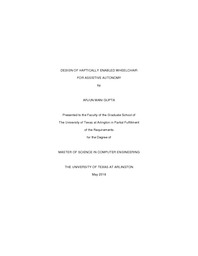
ATTENTION: The works hosted here are being migrated to a new repository that will consolidate resources, improve discoverability, and better show UTA's research impact on the global community. We will update authors as the migration progresses. Please see MavMatrix for more information.
Show simple item record
| dc.contributor.advisor | Záruba , Gergely V | |
| dc.contributor.advisor | Huber, Manfred | |
| dc.creator | Mani Gupta, Arjun | |
| dc.date.accessioned | 2018-06-05T18:22:10Z | |
| dc.date.available | 2018-06-05T18:22:10Z | |
| dc.date.created | 2018-05 | |
| dc.date.issued | 2018-05-14 | |
| dc.date.submitted | May 2018 | |
| dc.identifier.uri | http://hdl.handle.net/10106/27451 | |
| dc.description.abstract | The first records of wheeled seats being used for transporting disabled people date to 8th century in China, however the wheelchair has evolved tremendously since its inception. An electric-powered wheelchair, commonly called a "powerchair" is a wheelchair which incorporates batteries and electric motors into the frame, and so it can be controlled by either the user or an attendant. This control is most commonly done via a small joystick mounted on the armrest, or on the upper rear of the frame. For users who cannot manage a manual joystick, head-switches, chin-operated joysticks, sip-and-puff controllers or other custom controls may allow independent operation of the wheelchair. Although these interfaces make the wheelchair easier to operate, they do not help the user to navigate, nor do they make the user aware of the obstacles in the path of the wheelchair.
In this thesis we are exploring how haptic feedback can be coupled with a short-range navigation system to make powerchairs smarter. More precisely, we employ and modify an off-the shelf haptic joystick for both getting the intended direction of motion from the user as well as providing the user with the haptic feedback in case there are obstacles that prevent the powerchair to move on its current trajectory. The smart powerchair builds and maintains a map based on obstacles that are sensed with a LIDAR (Light Detection and Ranging) using simultaneous localization and mapping (SLAM); this information is then used to provide haptic feedback and perform navigation and obstacle avoidance. The system contains custom designed hard- and firm-ware to communicate with the original wheelchair controller. The overarching custom software architecture is designed and built over ROS (The Robot Operating System). | |
| dc.format.mimetype | application/pdf | |
| dc.language.iso | en_US | |
| dc.subject | Haptics | |
| dc.subject | Force-feedback | |
| dc.subject | Semi-autonomous wheelchair | |
| dc.subject | Assistive wheelchair | |
| dc.title | DESIGN OF HAPTICALLY ENABLED WHEELCHAIR FOR ASSISTIVE AUTONOMY | |
| dc.type | Thesis | |
| dc.degree.department | Computer Science and Engineering | |
| dc.degree.name | Master of Science in Computer Science | |
| dc.date.updated | 2018-06-05T18:24:18Z | |
| thesis.degree.department | Computer Science and Engineering | |
| thesis.degree.grantor | The University of Texas at Arlington | |
| thesis.degree.level | Masters | |
| thesis.degree.name | Master of Science in Computer Engineering | |
| dc.type.material | text | |
| dc.creator.orcid | 0000-0001-6075-5745 | |
Files in this item
- Name:
- MANIGUPTA-THESIS-2018.pdf
- Size:
- 1.529Mb
- Format:
- PDF
This item appears in the following Collection(s)
Show simple item record


